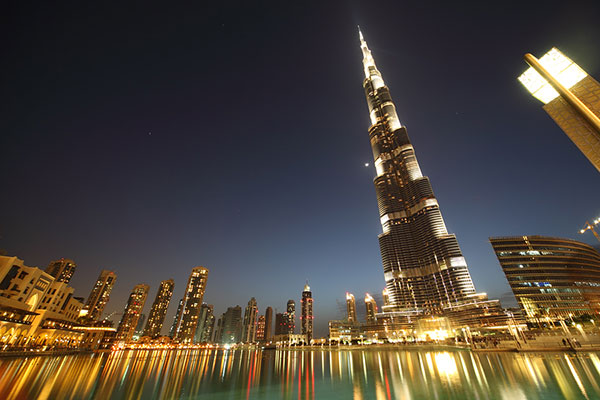
Burj Khalifa ... an integrated vertical city
Lessons from the construction of the Burj Khalifa
DUBAI, April 4, 2017
The construction of the world’s tallest building and iconic landmark, the Burj Khalifa was envisaged as more than just the tallest structure in the world – it represents an integrated vertical city, one that uses innovation, a report said.
The report titled “Shaping the Future of Construction: Inspiring Innovators Redefine the Industry” compiled by the World Economic Forum in collaboration with The Boston Consulting Group (BCG) analyzes the construction of the Burj Khalifa among other innovative construction projects.
The innovation cases in the report illustrate the value of embracing innovations. Prominent flagship projects, such as Dubai’s Burj Khalifa, the world’s tallest building, showcase state-of-the-art innovation.
Even in its planning stages in 2002, it was clear that many innovations would be needed in the design, construction and building technologies. The initial design brief was for a building of 550 meters. When the planned height subsequently increased to 750 meters, the innovation imperative became even clearer.
And more so still when the main contract was awarded in 2004: the target height at that stage had surged again – with the encouragement of the visionary, Sheikh Mohammed Bin Rashid al Maktoum, Vice-President and Prime Minister of the United Arab Emirates and Ruler of Dubai – and necessitated static recalculations of the foundations.
“To paraphrase William Gibson: the future of construction is here now—it is just not evenly distributed. Innovative companies and projects, as described in the report, demonstrate the art of the possible and how to address the challenges involved,” said Philipp Gerbert, a BCG senior partner and co-author of the report.
“The impact of these innovations on the traditional construction ecosystem will be interesting to follow. We see a widening gap between the innovation laggards and leaders, in particular with regards to their digital transformation.”
Companies need to spearhead industry transformation
On the basis of BCG’s analysis of these successful innovators, the report suggests ways for companies to stimulate innovative ideas, turn those ideas into reality, and ultimately succeed in the market.
Pioneering firms, for instance, create an innovation-friendly culture that rewards risk taking; they take a longer-term product perspective, rather than thinking in terms of individual projects; and they proactively shape the regulatory environment.
Burj Khalifa, for example, is an exemplary model of firms incubating an innovative environment. Property developer Emaar Properties invested great efforts into assembling a project team from across the world, with both experience and expertise in super high rise construction.
A collaborative initiative by multiple entities has led to the Burj Khalifa breaking several world records for buildings, to become an iconic urban landmark. At 828 meters, the world’s tallest building and tallest man-made structure, took less than four years from the first excavation works to overtake Taipei 101 as tallest building, and just three additional years to reach completion. Today the building attracts thousands of visitors every day, making Downtown Dubai a favourite urban destination.
Governments’ crucial contribution
Governments are crucial participants in the transformation of the construction industry. They need to create an environment conducive to the adoption of innovative technology as a regulator, strategic incubator, or project owner. In terms of the construction of the Burj Khalifa, negotiations with government authorities got underway almost immediately.
Local consultants, specially hired for the purpose, liaised with the Dubai municipality for building approvals, with Dubai Civil Defence for fire, live and safety protection, and with the local utility company for electricity.
In light of this, the report highlights the benefits of such crucial engagement with governments using the Burj Khalifa as a case point and also recommends that that governments should update building codes, move to performance-based and forward-looking standards, and introduce more flexible procurement models in infrastructure projects to overcome typical hurdles for innovation.
Lessons from the Construction of the Burj Khalifa
Essentially, there are four lessons that the report takes away from the Burj Khalifa construction project:
1. Develop and maintain a vision to motivate everybody and to reject the status quo. The unwavering vision behind the Burj Khalifa inspired the project team to go beyond the known limits – increasing the building’s height and implementing still-unproven processes and technologies.
2. Assemble and experienced, best-in-class team to drive innovation. The Burj Khalifa project did not compromise on excellence. The handpicked expert team had the effect of maximizing knowledge transfer, optimizing logistics management, exploiting prefabrication to the full and facilitating expert collaboration.
3. Collaborate closely with suppliers to develop, test and implement innovations. The expertise of the various partners was invoked as early as the planning phase, to enable pre-emptive modifications and avert costly reworks.
4. Engage regulatory authorities early on to speed up the approval process. The Burj Khalifa project team, being so experienced, promptly approached and negotiated with the relevant Dubai government agencies and utilities providers to expedite the official go-ahead and overcome any subsequent obstacles that might arise. – TradeArabia News Service







